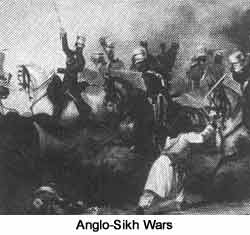

 |  |
 The growth of the Sikh power under Maharaja Ranjit Singh had made the British East India Company anxious, so they concluded a treaty with Ranjit Singh in 1809, known as the treaty of Amritsar. Under the agreement river Sutlej was recognized as the separation between both the empires. The agreement stopped the immediate expansion of the Sikh Empire under Ranjit Singh towards the east yet Ranjit Singh conquered Attock(1813), Kashmir(1819), Dera Gazi Khan(1820), Dera Ismail Khan(1821), Peshawar, Kangra, Multan, etc in the south, west & north. But after his death at the age of 59 his successors weren't able to provide the right kind of leadership required to sustain such a huge empire. After various pretensions and bloodbath finally the youngest son of Ranjit Singh, Dileep Singh took charge of his empire in 1843 under the guidance of his mother, Queen Jhindan. But he too was unable to cope up with the internal dissensions.
The growth of the Sikh power under Maharaja Ranjit Singh had made the British East India Company anxious, so they concluded a treaty with Ranjit Singh in 1809, known as the treaty of Amritsar. Under the agreement river Sutlej was recognized as the separation between both the empires. The agreement stopped the immediate expansion of the Sikh Empire under Ranjit Singh towards the east yet Ranjit Singh conquered Attock(1813), Kashmir(1819), Dera Gazi Khan(1820), Dera Ismail Khan(1821), Peshawar, Kangra, Multan, etc in the south, west & north. But after his death at the age of 59 his successors weren't able to provide the right kind of leadership required to sustain such a huge empire. After various pretensions and bloodbath finally the youngest son of Ranjit Singh, Dileep Singh took charge of his empire in 1843 under the guidance of his mother, Queen Jhindan. But he too was unable to cope up with the internal dissensions. Prevailing chaos invited the British East India Company to fish in the troubled waters. They started a military build up in the eastern fringe of Sutlej, concerned Sikhs made a huge political blunder by breaking the treaty of Amritsar and crossing the river Sutlej. On 13th December, 1845 British Governor General Henry Hardinge declared war on the Sikhs. Between 1845 to 1849 Sikhs and the British fought two wars. The first war was fought in Mudki on 18th December 1845. Sikhs under there Prime Minister Lal Singh attacked and got a decisive edge over the British, but the sudden running away of Lal Singh from the battle field at a time when the battle was at its pinnacle gave a huge blow to the Sikh morale. Again on 21st December 1845 the two armed forces met at Ferozeshahar, again the sudden running away of Lal Singh and General Teja Singh led to the defeat of the Sikhs. But the Sikhs caused a reversal on 21st January, 1846 when under the leadership of Ranjodh Singh and Ajit Singh they defeated the army of Harry Smith. The Sikhs and the British fought two more battles on 28th January at Aliwal and on 10th February at Sobraon. These battles led to the Treaty of Lahore, in which the Sikh territories east of Sutlej were confiscated also the Sikhs were forced to surrender Julundhur - Doab region to the British. Also Sikhs were forced to hand over Kashmir as a fine to the British which the British East India Company later sold to Maharaja Gulab Singh of Jammu for 10 Lakh Pounds. The King and his queen Mother were later on pensioned off. The Second Anglo-Sikh War at Chilianwala :- But the truce was not long lasting. A succession controversy resulted in the resignation of the then Governor of Multan, Moolraj. His resignation brought in a era of chaos and confusion. So to control the situation two British Officers under Khan Singh were deputed to Multan but both the British Officers were murdered there. Soon Queen Mother Jhindan was arrested and charged with treason and inciting other Sikhs. She was deposed. This disgraceful behavior with the Queen Mother triggered of the second Anglo-Sikh war. On 13th January, 1849 both the Sikh and the British Forces under Lord Guff met. The Sikh forces were lead by Jawahar Singh Nalwa. This was the most gruesome battle the British forces ever fought. The total British losses in terms of the dead and the injured were approximately 2, 400 which included 89 officers. But the battle was indecisive so the next battle was fought in Gujarat on 21st February but this time the Sikhs lost decisively. On 12th of March the Sikhs finally laid down there arms and on 29th March Punjab was annexed to the British dominion of India. The end of this section |
Copyright ©2000 indiansaga.info. All rights reserved.
By using this service, you accept that you won't copy or use the data given in this website for any commercial purpose.
The material on indiansaga.info is for informational & educational purpose only.
This site is best viewed at 800 X 600 picture resolution.